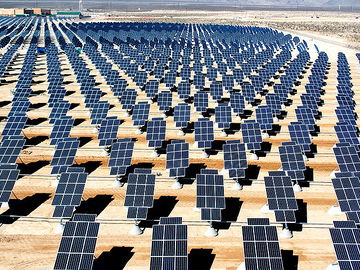Photovoltaic system

A photovoltaic system, sometimes known as a solar array, is a system composed of one or more solar panels combined with an inverter to generate electricity. These systems use energy from the Sun in the form of sunlight to generate this electricity. An array is comprised of solar panels in any number of combinations to meet voltage and current demands required from an electrical load.[2] This versatility allows photovoltaic arrays to be of any size. For example, they may be installed on the roof of a home or may take up as much space as 950 acres.[3]
How do these Systems Work?
The light from the Sun, or solar energy, falls onto a solar panel and transfers energy to the material by knocking an electron loose. When these free electrons are in sufficient number, electricity is generated from the solar panel in the form of direct-current or DC electricity. Depending on where the electricity will be used, it must be converted from DC to alternating-current or AC via an inverter. This process takes place in the individual solar cells that are used to create the solar panel. The process by which these cells generate the electricity is known as the photovoltaic effect.
How do Solar Cells Work?
A photovoltaic, PV, or solar cell is a semiconductor with specific properties encapsulated within a material to protect it from the environment. These properties enable the cell to capture light, or more specifically, the photons from the sun. As light shines on a solar cell, it may either be absorbed, reflected, or pass right through.
The photons that are absorbed by the material are used to generate electricity.[4] The amount of energy varies with each photon depending on its wavelength. A photon with the right amount energy entering a solar cell will dislodge an electron from the atoms of the material leaving behind a hole. The accumulation of electrons and holes results in a voltage potential building up within the cell and creating what can be described as a battery with a positive and negative terminal.[5] By completing the circuit, a path is created for these electrons to flow. This flow of electrons is known as electricity and is in the form of direct-current.
Performance
The generating capability of a solar panel is directly related to its exposure to sunlight. A properly installed solar panel will be tilted towards the direction of the Sun to maximize its sunlight exposure time. Obstructions such as cloudy weather, trees, or buildings that shade the solar panels will decrease the amount of electricity that is produced. In addition, different geographic regions have access to various levels of sunlight, affecting the availability of the sun and the level of insolation.
References
- ↑ Wikimedia Commons. (August 19, 2015). Giant Photovoltaic Array [Online]. Available: https://upload.wikimedia.org/wikipedia/commons/thumb/4/45/Giant_photovoltaic_array.jpg/640px-Giant_photovoltaic_array.jpg
- ↑ U.S. Department of Energy. (2013, August 20). Photovoltaic Systems [Online] Available: http://www.eia.gov/energyexplained/index.cfm?page=solar_photovoltaics
- ↑ Enbridge. (2010, October 4). Enbridge and First Solar Complete the Largest Photovoltaic Facility in the World [Online]. Available: http://www.enbridge.com/MediaCentre/News.aspx?yearTab=en2010&id=1329131
- ↑ U.S. Department of Energy. (2013, August 13). Photovoltaic Cells [Online]. Available: http://energy.gov/eere/energybasics/articles/photovoltaic-cells
- ↑ U.S. Energy Information Administration. (2012, April 19). Photovoltaics and Electricity [Online]. Available: http://www.eia.gov/energyexplained/index.cfm?page=solar_photovoltaics

